|
Related FAQs: Nudibranchs,
Nudibranchs 2, Nudibranch Identification,
Nudi ID 2, Nudi ID 3,
Nudi ID 4, & Nudibranch Behavior, Nudibranch Compatibility, Nudibranch Selection, Nudibranch Systems, Nudibranch Feeding, Nudibranch Disease, Nudibranch Reproduction, Berghia Nudibranchs, Marine Snails 1, Marine Snails 2, Marine Snails 3, Marine Snails 4, Sea Slugs, Seaslugs 2, Snail ID 1, Snail ID 2, Snail ID 3,
Related Articles: Dorid et al. Nudibranchs pt. 2, Aeolid Nudibranchs pt. 3, Sea Slugs, Gastropods, Mollusks,
Aiptasia/Glass Anemones
/The Conscientious Marine Aquarist
Nudibranchs, The Naked-Gill Sea Slugs,
pt. 1, Dorids
To: Pt. 2,
Pt. 3,
Pt. 4,
Pt. 5,
Pt. 6,
Pt. 7,
Pt. 8, Pt. 9,
Pt. 10, Pt. 11,
Pt. 12, Pt. 13,
Pt. 14, Pt. 15,
Pt. 16
|
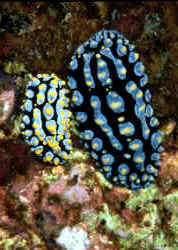
|
|
By Bob Fenner
|
Phyllidia arabica
|
Order Nudibranchia- Naked-gill sea slugs. Largest
of the five Orders of Opisthobranch gastropods. Lack shells, are
carnivorous (feed on sessile invertebrates like sponges, sea fans,
hydroids, corals... some are predaceous on other nudibranchs.). Lack
predators by and large themselves due to unpalatability, toxicity,
venom... mainly from recycled molecules via their prey.
Bigger PIX:
The images in this table are linked to large
(desktop size) copies. Click on "framed" images to go to
the larger size. |
|
MD.JPG)
|
Considering their small size, often bizarre body shapes
and dazzling coloration, it's no wonder nudibranchs are often
unidentified by divers, aquarists and tide-poolers for what they are;
marine snails that lack shells, just like their lowly terrestrial
cousins found sliming around under rotting wood and vegetation.
But most of us emote "oohs" and
"aahhs" rather than "yecch" when we view these
"butterflies of the sea". Unfortunately, few efforts at
keeping them in captivity have been successful. Many failures, as
you'll see, are aquarist-originated; chemical poisoning, unstable
conditions, and most importantly, starvation.
Diversity/Classification:
Nudibranchs are mollusks (Phylum Mollusca, =
"Soft-bodied" animals a group including squids, octopi,
abalones, Chitons, tusk shells, mussels, scallops, oysters... Further
sub classified, they belong to the Class Gastropoda, the
"stomach-footed" mollusks (snails and their relatives); which
are still further divvied up into the Subclass Prosobranchia- with a
mantle cavity and organs located anteriorly in their classically
twisted (or torted) shells. Our group is the other Subclass, the
Opisthobranchia, shows a reduction of shell and mantle cavity; many are
de-torted, that is, secondarily bilaterally symmetrical.
The Order Nudibranchia is one of nine extant Orders in
the Subclass; they lack shells and mantle cavities. To review:
Phylum Mollusca
Class Bivalvia, et al.
Class Gastropoda
Subclass Prosobranchia ("ahead
gills")
Subclass Opisthobranchia ("behind
gills"). Have Rhinophores; sensory organs for chemicals,
currents. Below: Rhinophores anteriorly, anal gills
posteriorly.
|
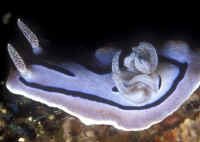 Rhinophores and gills... Rhinophores and gills...
|
Order Aplysiacea, et al. (sea-hares)
Order Nudibranchia- Naked-gill sea
slugs,
Suborder
Doridacea- Dorids
Suborder
Aeolidacea- Aeolids
Suborder
Dendronotidacea- Usually have an oral hood and series of
cerata running down their backs.
Suborder
Arminacea
The nudibranchs comprise four sub-orders, about seventy
families and one thousand-plus valid species. Two of the sub-orders are
rarely seen in the hobby, the Dendronotacea and Arminacea, but the
following information concerning the other two groups applies to
them.
Suborder Doridacea, Dorids:
('Door-idz'), (Suborder Doridacea) dwell in rocky
intertidal zones worldwide, sometimes in good numbers. Their
mantles cover their entire dorsal surface and
hang over their foot. Their gill plumes are arranged around a rear anal vent area and
are capable of retraction into a specialized pocket. The chemosensory
tentacles, or rhinophores at the head end can
likewise be retracted.
Family Chromodorididae: More than 360 species in
the Indo-Pacific, Caribbean, Mediterranean... the genus Chromodoris
alone with 165... colorful generally. Typified by oval mantles that
cover their foot entirely. Their posterior located secondary anal gills
are pinnate, one pair of tentacles, rhinophores lamellate.
Genus Anisodoris:
| Anisodoris nobilis Bergh,
1898, Sea Lemon, Pacific sea lemon, Noble pacific doris. E.
Pacific; Alaska to Baja California; low intertidal to 35 m. To more
than 8 inches in length. This one at the SIO Birch Aq., San Diego,
CA. |
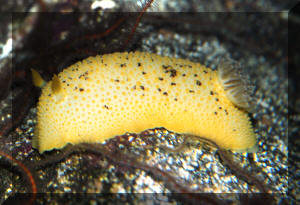
|
Genus Cadlinella:
| Cadlinella ornatissima (Risbec 1928). Red
Sea, Indo-Pacific; Malaysia to Australia. To 2 cm. N. Sulawesi
(Lembeh Strait) pic. |
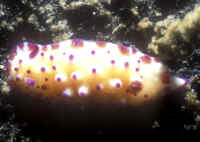
|
Genus Ceratosoma: Long-bodied, tailed, highly
branched gills. Mantles with prominent lateral extensions.
| Ceratosoma alleni Gosliner 1996. A mimic and found on
shallow reefs dominated by Xeniid colonies. To 50 mm. Indo-Pacific. Northern Sulawesi. |
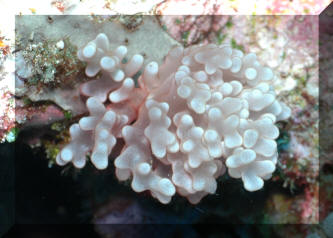
|
| Ceratosoma gracillimum Semper in Bergh,
1876. Tropical east to west Pacific.. To 2 cm./.75" Note absece of marginal
lateral lobes connecting the heads with the "arms". N. Sulawesi image. |
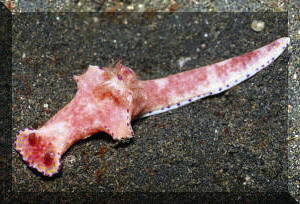
|
Bigger PIX:
The images in this table are
linked to large (desktop size) copies. Click on "framed"
images to go to the larger size. |
%20MD.JPG)
%20MD.JPG) |
Ceratosoma trilobatum (J.E. Gray 1827). Distinguished from
the similar appearing and overlapping distributed C. tenue
by the possession of three lobes on the forward body, and a continuous
marginal purple line. N. Sulawesi
pix.
http://www.seaslugforum.net/ceratril.htm
|
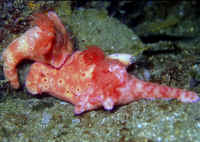
|
Bigger PIX:
The images in this table are
linked to large (desktop size) copies. Click on "framed"
images to go to the larger size. |
%20MD.jpg)
%20MD.JPG) |
Genus Chromodoris: Largest genus of
Nudibranchs.
| Chromodoris bullocki Collingwood 1881.
Variable in color... sometimes almost all white or pink with a
white margin. Gills and rhinophores with red tips. Western Pacific;
Taiwan, Philippines, Indonesia. N. Sulawesi pic. |
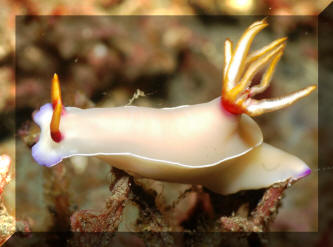
|
Bigger PIX:
The images in this table are linked to large (desktop size) copies.
Click on "framed" images to go to the larger size. |
.JPG)
.JPG)
%20MD.jpg) |
| Chromodoris collingwoodi. West Pacific. To 4.5
cm/1.75". Bali 2014 |
%20MD.JPG)
|
| Chromodoris fidelis. Red Sea to the Marshall
Islands. To 4 cm. Said to feed exclusively on the Purple Sponge,
Aplysilla violacea. N. Sulawesi pic. |
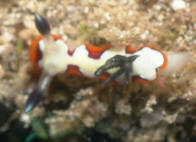 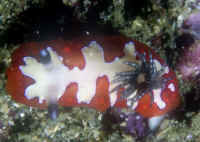
|
| Chromodoris kempfi
Purple-Crowned Sea Goddess. To 3/4". Bonaire 2016, Di Pic. |
%20MD.JPG)
|
To: Pt. 2, Pt.
3,
Pt. 4,
Pt. 5,
Pt. 6,
Pt. 7,
Pt. 8, Pt. 9,
Pt. 10, Pt. 11,
Pt. 12, Pt. 13,
Pt. 14, Pt. 15,
Pt. 16

